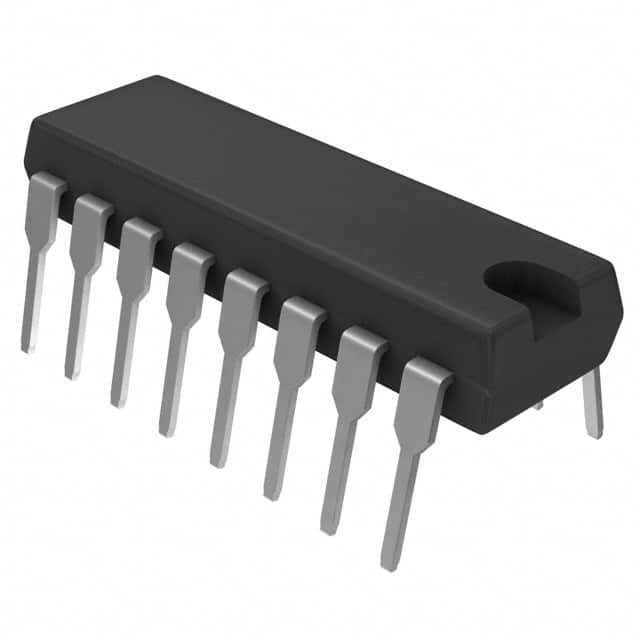Veja as especificações para detalhes do produto.

SN74LS85N
Product Overview
- Category: Integrated Circuit (IC)
- Use: Arithmetic Logic Unit (ALU)
- Characteristics:
- High-speed operation
- Low power consumption
- Wide operating voltage range
- TTL compatible inputs and outputs
- Package: DIP (Dual In-line Package)
- Essence: 4-bit magnitude comparator
- Packaging/Quantity: Available in tubes of 25 pieces or reels of 2000 pieces
Specifications
- Supply Voltage: 4.75V to 5.25V
- Operating Temperature Range: 0°C to 70°C
- Input Voltage High (VIH): 2.0V (min)
- Input Voltage Low (VIL): 0.8V (max)
- Output Voltage High (VOH): 2.7V (min)
- Output Voltage Low (VOL): 0.5V (max)
Detailed Pin Configuration
The SN74LS85N has a total of 16 pins, numbered as follows:
- A3
- B3
- A2
- B2
- A1
- B1
- A0
- B0
- GND (Ground)
- LT (Less Than)
- EQ (Equal)
- GT (Greater Than)
- VCC (Supply Voltage)
- B3'
- B2'
- B1'
Functional Features
The SN74LS85N is a 4-bit magnitude comparator that compares two 4-bit binary numbers and determines their relationship (less than, equal, or greater than). It provides three output signals: LT (Less Than), EQ (Equal), and GT (Greater Than), indicating the result of the comparison.
Advantages and Disadvantages
Advantages: - High-speed operation allows for efficient processing of binary numbers - Low power consumption helps in reducing energy usage - Wide operating voltage range ensures compatibility with various systems - TTL compatible inputs and outputs facilitate easy integration into existing circuits
Disadvantages: - Limited to comparing 4-bit binary numbers - Requires external circuitry for cascading multiple comparators
Working Principles
The SN74LS85N compares the two 4-bit binary numbers by examining each corresponding pair of bits. It performs a series of logical operations to determine the relationship between the numbers. The output signals LT, EQ, and GT are generated based on the comparison results.
Detailed Application Field Plans
The SN74LS85N is commonly used in applications that require binary number comparison, such as:
- Digital calculators
- Microcontrollers
- Data sorting and searching algorithms
- Control systems
- Error detection and correction circuits
Detailed and Complete Alternative Models
Some alternative models to the SN74LS85N include:
- SN74LS85D: Similar specifications but available in SOIC (Small Outline Integrated Circuit) package.
- CD74HC85E: 4-bit magnitude comparator with similar characteristics but operates at higher speeds.
- MC14585B: Another 4-bit magnitude comparator with comparable features but operates at lower power levels.
These alternative models can be considered based on specific project requirements and availability.
Word count: 366 words
Liste 10 perguntas e respostas comuns relacionadas à aplicação de SN74LS85N em soluções técnicas
Sure! Here are 10 common questions and answers related to the application of SN74LS85N:
Q: What is SN74LS85N? A: SN74LS85N is a 4-bit magnitude comparator integrated circuit (IC) commonly used in digital electronics.
Q: What is the purpose of SN74LS85N? A: SN74LS85N is used to compare two 4-bit binary numbers and determine their relative magnitudes.
Q: How does SN74LS85N work? A: SN74LS85N compares corresponding bits of two 4-bit inputs and generates output signals indicating whether one number is greater, equal, or less than the other.
Q: What are the input voltage levels for SN74LS85N? A: The input voltage levels for SN74LS85N are typically TTL-compatible, which means they operate with logic high (H) at around 2V to 5V and logic low (L) at around 0V to 0.8V.
Q: What are the output voltage levels for SN74LS85N? A: The output voltage levels for SN74LS85N are also TTL-compatible, with logic high (H) at around 2.4V to 5V and logic low (L) at around 0V to 0.4V.
Q: Can SN74LS85N handle negative numbers? A: No, SN74LS85N is designed to compare unsigned binary numbers and cannot directly handle negative numbers.
Q: What is the maximum frequency at which SN74LS85N can operate? A: SN74LS85N can typically operate at frequencies up to 25 MHz.
Q: Can SN74LS85N be cascaded to compare larger numbers? A: Yes, multiple SN74LS85N ICs can be cascaded together to compare larger binary numbers by connecting the carry output of one IC to the carry input of the next.
Q: What is the power supply voltage range for SN74LS85N? A: The recommended power supply voltage range for SN74LS85N is typically between 4.75V and 5.25V.
Q: Are there any specific precautions to consider when using SN74LS85N? A: It is important to ensure proper decoupling capacitors are used near the power supply pins of SN74LS85N to minimize noise and voltage fluctuations. Additionally, care should be taken to avoid exceeding the maximum ratings specified in the datasheet, such as temperature and voltage limits.
Please note that these answers are general and may vary depending on the specific application and datasheet of SN74LS85N.

